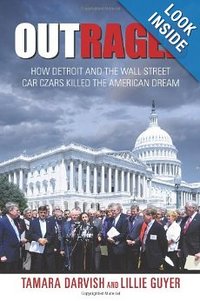Outraged! How Detroit and Wall Street Car Czars Killed the American Dream - Book Review
OUTRAGED!
Book Authored By Tamara Darvish and Lillie Guyer
Published by iUniverse, Bloomington, VT
A BOOK REVIEW By Steve Purdy
Prepare to be outraged…I was throughout the 400 pages of this important book written by one of the auto dealers in the very center of the auto bailout controversy from Maryland and a veteran automotive journalist from Detroit.
Tamara Darvish and her family run a group of Washington DC-area automobile dealerships and she ended up co-leading a monumental effort in Congress, among fellow dealers and through the media to expose the injustices wrought by the arbitrary elimination of large numbers of dealers during the bankruptcies of General Motors and Chrysler. The goal was the restoration of the rights of these dealers but the process did so much damage that the auto business can never be the same.
Lillie Guyer put it all into words skillfully telling the seemingly endless stories of businesses all over the country, many generational family dealerships, that were caught up in what seemed like a frenzy of dealer body downsizing instigated by the government and embraced by the companies. Guyer’s amazing ability to tell these poignant, human stories weaving them into a coherent narrative makes this book one you’ll want to stick with until the end.
It was not an easy read though. So many stories needed to be told that I found it a bit tedious at times and had trouble sticking with it for more than an hour at a time. So many players in this drama of injustice, oppression and government overreach had so many stories to tell that it became confusing at times trying to keep track of the names and scenarios. Many of the scenarios, though, were similar - profitable dealers being called unprofitable; high performers being called low performers; numbers being misquoted; and on and on. The motivation of the companies to get rid of certain dealers appeared to be based on criteria other than performance.
Then there was the practice of canceling the franchise of a dealer and simply giving it to someone else, essentially, taking one businessman’s property and gifting it to another with not compensation to the former. Stories like these are a recurring theme in the book and should trigger outrage in anyone who believes in property rights.
This exposeŽ of dealer closures, insisted upon by the government as part of the auto industry bailouts resulting from the Great Recession and embraced by GM and Chrysler, resulted in a chaotic system of abrupt and heartless dumping of some of those companies’ best dealers, according to this narrative. While the manufacturers were touting a system based on getting rid of underperforming and weak dealers and the government was insisting on leaner dealer bodies for both, it seems from this book that neither of those criteria were used or made sense from a business perspective.
Darvish was a central figure in a grassroots organization of dumped dealers who doggedly pursued a legislative remedy to restore the rights of the ill-treated dealers. Congressional movers and shakers like Ted Kennedy, John Kerry, Dick Durbin, Chuck Grassley, Steny Hoyer and others took up the gauntlet and helped pass a measure that would at least allow all the effected dealers an opportunity at arbitration. The strategies and work leading up to that legislative effort form a substantial part of the book. So the political intrigue adds a bit of flavor to a story that wants to stick in your craw.
When I arranged to review this book I asked Ms. Guyer if I would get answers to the burning questions in my mind about this whole matter. That is, why they wanted to get rid of these dealers and precisely what does it cost manufactures to have a dealer. Isn’t it a fact, I thought, that the more dealers selling your project the more product you’re likely to sell? She insisted I’d find some of the answers I sought.
I had asked this question of industry analysts before, including David Cole of the Center for Automotive Research, who is often referenced in this book, and never got answers that made any sense. I still do not have an understanding of how fewer dealers add to the sales equation.
Well, I guess I found hints at some of those answers – but not all. Guyer and Darvish make the point repeatedly that the dealers are essentially the manufacturers only customers. So why would you want to limit your customer base? Why would it matter to the manufacturer to have fewer, bigger dealers leaving small markets underserved – particularly for these iconic U.S. brands? And, my central question is: what exactly does it cost a manufacturer to have a dealer on board?
Some of the answers are implied rather than proven, though evidence exists to show there was some vindictiveness in these decisions. You’ll need to read the book to get the whole story, at least from the dealers’ side, but it seems there were many less-than-reasonable motives involved.
If you want to understand what happened during this dismal period of business history you need to read this book. Though be prepared to still have questions in the end.
Available at your local book store or Amazon
© Steve Purdy, Shunpiker Productions, All Rights Reserved



